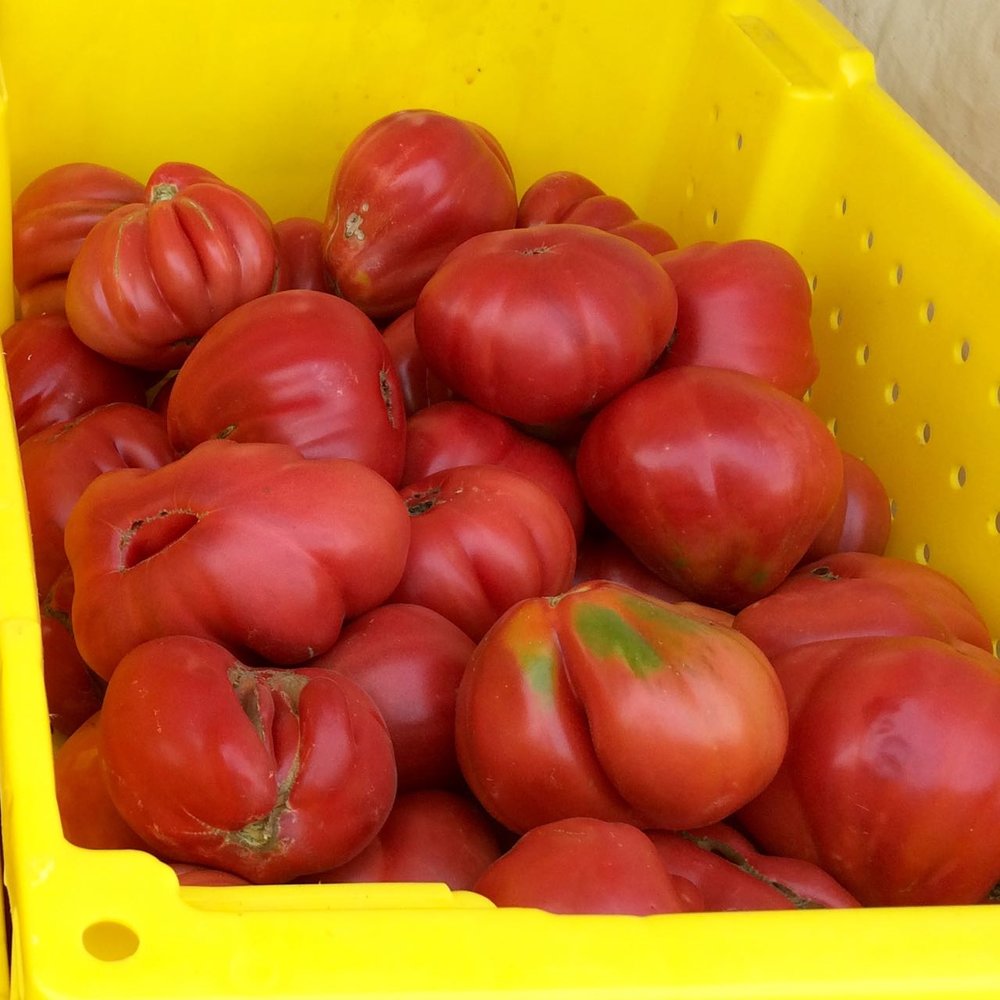Ayers Creek Farm Newsletter August 30 2015 Market

Anticipating the weather shift, we have harvested a van load of grapes, prunes, mirabelles, tomatillos, onions and Astianas for tomorrow's market.
We had several questions about making tomato sauce last week. Here are our thoughts. Despite what food writers stress, fully ripe or over-ripe fruit should be avoided for canning purposes, use these in a fresh sauce. (Another calumny of the present crop of food writers is that tomatoes instantly stop ripening when they are picked from the vine. This is absolute nonsense, foolish fussiness from people who are paid to know better but never seem to actually work with fruits, just write about them.) We find the brightest and most flavorful sauce comes from fruit on the near side of ripeness, a diversity of stages produces a more interesting sauce. Avoid the fixation on color; flavor is what counts come January. A high level of acidity assures a bright and flavorful sauce.
We resist the Macbeth "boil and bubble, toil and trouble" approach to sauce making. Nothing is gained from the drama of watching and stirring the cauldron, and it leads to time wasted and an over-cooked sauce. (Akin to putting berries one-by-one, never touch, on a cookie sheet prior to putting them in the freezer when it is much easier to put the whole flat in instead.) Cooking does not concentrate the sauce, heat facilitated evaporation does. Only at the canning stage is a higher heat briefly necessary.
We wipe off the whole tomatoes if needed, pierce them a few times with a knife and place them in a big oven pan. Mound them up as they will settle down as they cook, and sprinkle some salt over the top if desired, which helps preserve the color. Put the pan in a slow oven, around 200°F. You can leave them there for hours, or overnight. Periodically, we decant off the "nectar," the amber liquid that drains from the tomatoes. We put this into 1-quart canning jars as a stock for stews and soups. After the tomatoes have fully collapsed, we run them through a food mill. We also can some whole tomatoes.
At this point, the sauce is medium thick, and can be be canned. We also further concentrate some sauce by returning it to the low oven for a day or so. Slowly and gently, it will evaporate and thicken. We find this gentle heat produces a far better sauce than rushing the process over the stovetop flame. Commercial sauces are often made with a vacuum cooker which concentrates the sauce quickly at a relatively low temperature in the range of 180°. Once again, a gentle process but as of yet there are no home kitchen vacuum cookers. The oven method works very well.
We pressure can because, well, we have one, and it is fast and easy. You can also process in a hot bath per standard instructions because these traditional tomatoes are acidic enough. Many people freeze the sauce instead of using a canner. Although we put up over 100 pints of tomato sauce at varying degrees of thickness, we never add anything but salt. We prefer to add seasonings later. Caution applies especially to ingredients that lower the acidity (increase the pH) like peppers. The acidic nature of tomatoes makes them safe and easy to can. Best not to mess with that comfortable margin of safety.
Because Astiana is our own variety and not a precious heirloom or such, we can sell them at $35/20 pounds without shame, and you get the stylish Ayers Creek Farm lug in the bargain. We will have some tomatoes prepackaged and, with a measure of trepidation, accept requests to hold 20# lugs as supply permits. Please email us before 4:00, and we will try to fill requests for 20# lugs only. And don't fret if this isn't the week for you, we will have them for the next few weeks.
We will have lose tomatoes as well for those who want just a few pounds.
The Boutards
Ayers Creek Farm